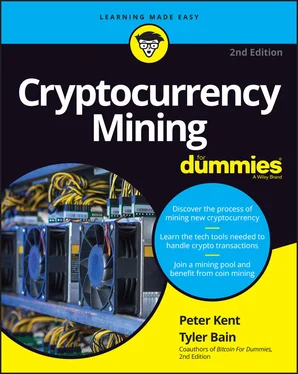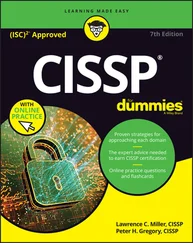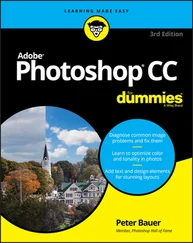 The Warning icon helps you stay out of trouble. It’s intended to grab your attention to help you avoid a pitfall that may harm your website or business.
The Warning icon helps you stay out of trouble. It’s intended to grab your attention to help you avoid a pitfall that may harm your website or business.
In addition to what you’re reading right now, this product also comes with a free access-anywhere Cheat Sheet that covers a variety of useful facts, such as background information on commonly mined cryptocurrencies, coin divisibility, popular pool mining services, and so on. To get this Cheat Sheet, simply go to www.dummies.com and enter Cryptocurrency Mining For Dummies Cheat Sheetin the Search box.
For information on Peter’s Crypto Clear: Blockchain & Cryptocurrency Made Simple video course, visit www.CryptoOfCourse.com .
As are all good reference tools, this book is designed to be read when needed. It’s divided into several parts: cryptocurrency background and basics; mining-related foundational information; how to get started in cryptocurrency mining; the economics of mining; and the Part of Tens. We recommend that you start at the beginning and read through sequentially, but if you just want to know how to find pool mining services, read Chapter 7. If you need to understand how to calculate what equipment you would need to mine a particular cryptocurrency, read Chapter 11. If all you need is to understand the different forms of mining, Chapter 4is for you.
However, cryptocurrency is a complex subject, and cryptocurrency mining more so. All the topics covered in this book are interrelated. We strongly recommend that you read everything in this book before you begin mining; it’s essential that you have a strong understanding of everything involved before you begin. After all, your money is at stake!
Part 1
Getting Started with Cryptocurrency Mining
IN THIS PART …
Review the basics of cryptocurrency.
Get acquainted with cryptocurrency mining.
Understand the blockchain and hashing.
Get to know the different forms of mining.
Chapter 1
IN THIS CHAPTER
 Discovering digital currency
Discovering digital currency
 Working with blockchain
Working with blockchain
 Hashing blocks
Hashing blocks
 Understanding public-key encryption
Understanding public-key encryption
 Signing messages with the private key
Signing messages with the private key
You may be eager to get your mining operation started, but before you can create cryptocurrency, we want to make sure you understand what cryptocurrency actually is.
The cryptocurrency thing is so new — or at least, most of the interest in cryptocurrency has occurred recently, even though cryptocurrencies of various forms have been around since the 1980s — that most people involved have a rather shaky understanding of what cryptocurrency is and how it works. The average cryptocurrency owner, for example, may not know what they own.
In this chapter, we review the history of cryptocurrency and how the different components function together. You’ll have a better foundation to understand how to mine cryptocurrencies if you understand what it is.
A Short History of Digital Dollars
Cryptocurrency is just one type of digital currency … a special type. At the end of the day cryptocurrency may be thought of as a form of digital currency.
So, what’s digital currency, then? Well, digital currency is a very broad term that covers a variety of different things. But in a general sense, it’s money that exists in a digital form rather than tangible form (think coins and banknotes). You can transfer digital currency over an electronic network of some kind, whether the Internet or a private banking network.
 In fact, even credit card transactions may be thought of as digital currency transactions. After all, when you use your credit or debit card at a store (online or off), the money is being transferred electronically; the network doesn’t package up dollar bills or pound notes and mail them to the merchant.
In fact, even credit card transactions may be thought of as digital currency transactions. After all, when you use your credit or debit card at a store (online or off), the money is being transferred electronically; the network doesn’t package up dollar bills or pound notes and mail them to the merchant.
The cryptocurrency story really all begins with the Internet. Digital currencies existed before the Internet was in broad use, but for a digital currency to be useful, you need, well, some kind of digital transportation method for that currency. If almost nobody is using a digital communications network — and until 1994 very few people did — then what’s the use of a digital currency?
But after 1994, millions of people were using a global, digital communications network — the Internet — and a problem arose: How can you spend money online? Okay, today the answer is pretty simple: You use your credit cards, debit cards, or PayPal account. But back in the mid-90s, it was more complicated.
Add credit card confusion
Back in the mid-90s, some of you may recall (and many of you were too young back then to remember this, I realize), people were wary of using credit cards on the Internet. When I had my own publishing company and was selling books through my website in 1997, I (Peter — Tyler’s too young to remember 1997) would often receive printouts of my website product pages in the mail, along with a check to pay for the book being purchased. I was taking credit cards online, but many people simply didn’t want to use them; they didn’t trust the Interwebs to keep their plastic safe.
In addition, setting up a payment gateway for credit cards was difficult and expensive for the merchant. These days, it’s a pretty simple process to add credit card processing to a website — it’s built into virtually all ecommerce software, and with services like Stripe and Square lowering the barriers of entry, getting a merchant account is no longer the huge hassle and expense it used to be.
Of course, we’re talking commercial transactions here, but what about personal transactions? How can someone send a friend the money they owe, or how can a parent send beer money to their child away at college? (I’m talking PPP … pre-PayPal and web-based transfers between bank accounts.) If we were going to live in a digital world, surely we needed digital money.
 One important characteristic of cash is that cash transactions are essentially anonymous — there’s no paper trail or electronic record of the transaction taking place. Plenty of people thought an equivalent form of anonymous or pseudonymous digital currency would be a vast improvement over traditional settlement methods.
One important characteristic of cash is that cash transactions are essentially anonymous — there’s no paper trail or electronic record of the transaction taking place. Plenty of people thought an equivalent form of anonymous or pseudonymous digital currency would be a vast improvement over traditional settlement methods.
So, many people thought there had to be a better way. We needed a digital currency for a digital world. These days, perhaps that viewpoint seems naïve; looking back it was obvious that the credit companies weren’t going to see trillions of dollars of transactions shifting online and just wave goodbye! They wanted a piece of the action, unwilling to give up their monopoly, and so today, the primary transaction methods in the United States and most of Europe are bank cards of various kinds.
Читать дальше

 The Warning icon helps you stay out of trouble. It’s intended to grab your attention to help you avoid a pitfall that may harm your website or business.
The Warning icon helps you stay out of trouble. It’s intended to grab your attention to help you avoid a pitfall that may harm your website or business. Discovering digital currency
Discovering digital currency In fact, even credit card transactions may be thought of as digital currency transactions. After all, when you use your credit or debit card at a store (online or off), the money is being transferred electronically; the network doesn’t package up dollar bills or pound notes and mail them to the merchant.
In fact, even credit card transactions may be thought of as digital currency transactions. After all, when you use your credit or debit card at a store (online or off), the money is being transferred electronically; the network doesn’t package up dollar bills or pound notes and mail them to the merchant. One important characteristic of cash is that cash transactions are essentially anonymous — there’s no paper trail or electronic record of the transaction taking place. Plenty of people thought an equivalent form of anonymous or pseudonymous digital currency would be a vast improvement over traditional settlement methods.
One important characteristic of cash is that cash transactions are essentially anonymous — there’s no paper trail or electronic record of the transaction taking place. Plenty of people thought an equivalent form of anonymous or pseudonymous digital currency would be a vast improvement over traditional settlement methods.










